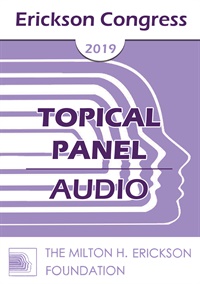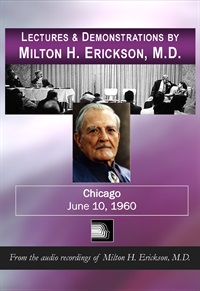
- Average Rating:
- Not yet rated
- Topic Areas:
- Workshops | Ericksonian Hypnosis and Therapy Techniques | Resistance | Suicide | Utilization
- Categories:
- Erickson Congress | Erickson Congress 2019
- Faculty:
- Eric Greenleaf, PhD
- Duration:
- 1 Hour 54 Minutes
- Format:
- Audio Only
- Original Program Date:
- Dec 12, 2019
- Short Description:
- Utilization of Dr. Erickson's approaches can be daunting. They are both meticulously planned and rehearsed, as with his Induction for Resistant Patients, and spontaneous and intuitive, responding at the moment to his patient. Dr. Greenleaf will present 7 of his own brief cases, each of which required spontaneous, intuitive response to patient needs. They are called: 2 Promises: Postcards, Death Grip; 2 Threats: Bust, “I Like That Wall”; 2 Doorways to Reality: “You Wonned”, “I’d Like to Have That Desk” and "3 Counter Tenors"
- Price:
- $15.00 - Base Price

- Average Rating:
- Not yet rated
- Topic Areas:
- Clinical Demonstrations | Psychotherapy | Interviewing | Resistance | Therapist Development
- Bundle(s):
- Pioneers of Psychotherapy Bundle
- Categories:
- Pioneers of Psychotherapy | Evolution of Psychotherapy | Evolution of Psychotherapy 1990
- Faculty:
- James Bugental, PhD
- Course Levels:
- Master Degree or Higher in Health-Related Field
- Duration:
- 01:00:00
- Format:
- Audio and Video
- Original Program Date:
- Dec 12, 1990
- Short Description:
- Bugental (1990) provides two demonstrations. First, Bugental works with Molly, an associate who is familiar with this approach at an advanced level. Next he works with a naïve client, demonstrating what therapy might look like on the first visit. After each session, Bugental and his client reflect upon his methods.
- Price:
- $59.00 - Base Price

- Average Rating:
- Not yet rated
- Topic Areas:
- Hypnosis | Ericksonian Hypnosis and Therapy Techniques | Milton Erickson | Binds | Resistance
- Categories:
- Erickson Materials | Lectures & Demonstrations | Milton H. Erickson Collections
- Faculty:
- Milton H. Erickson, MD
- Duration:
- 3:57:01
- Format:
- Audio Only
- Original Program Date:
- Jun 10, 1960
- Short Description:
- During this seminar, Dr. Erickson describes essential skills for working with resistant patients, the use of permissive language, ordeal therapy, geometric progression, and therapeutic double binds. Erickson conducts a demonstration, answers questions from the audience, and elaborates on his thinking with case illustrations that include: sexual dysfunction, stuttering, bed wetting, childhood eating disorders, compulsive habits, phobias and self-defeating behavior.
- Price:
- $40.00 - Base Price
Please wait ...

